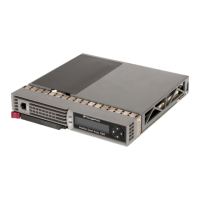48 Storage overview
In each mirrored pair, the physical drive that is not busy answering other requests answers any read
requests that are sent to the array. (This behavior is called load balancing.) If a physical drive fails, the
remaining drive in the mirrored pair can still provide all the necessary data. Several drives in the array can
fail without incurring data loss, as long as no two failed drives belong to the same mirrored pair.
RAID 1+0 is useful when high performance and data protection are more important than the cost of
physical drives.
RAID 5—Distributed data guarding
In this method, a block of parity data is calculated for each stripe from the data that is in all other blocks
within that stripe. The blocks of parity data are distributed across every physical drive within the logical
drive (Figure 7). When a physical drive fails, data that was on the failed drive can be calculated from the
data on the remaining drives and the parity data. This recovered data is written to the assigned spare or to
a replacement drive in a process called a rebuild.
Figure 7 RAID 5 array, with three physical hard drives (D1, D2, and D3) showing distributed parity
information (Px,y)
This configuration is useful when cost, performance, and data availability are equally important.
RAID 6—Advanced data guarding
RAID 6 (also called RAID ADG) is similar to RAID 5, because both methods generate and store parity
information to protect against data loss caused by drive failure. With RAID 6, however, two different sets of
parity data are distributed across the physical drives, allowing data to be preserved even if two drives fail.
Each set of parity data uses up a capacity equivalent to that of one of the constituent drives, as shown in
Figure 8.
Table 4 RAID 1, RAID 1+0 features
Advantages Disadvantages
Highest read and write performance of any
fault-tolerant configuration.
Expensive (half of the drives are used for fault
tolerance).
No loss of data as long as no failed drive is
mirrored to another failed drive.
Only half of total drive capacity usable for data
storage.
Table 5 RAID 5 features
Advantages Disadvantages
Highest read performance. Relatively low write performance.
No loss of data if one physical drive fails. Loss of data if a second drive fails before data
from the first failed drive is rebuilt.
More usable drive capacity than RAID 1+0,
because parity information requires the storage
space equivalent to one physical drive.
S1
S2
S3
S4
B1
B3
P5,6
P3,4
P1,2
P7,8
B7
D1 D2 D3
B2
B5
B8
B4
B6
1531

